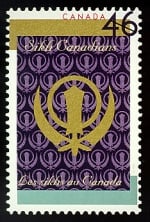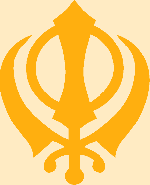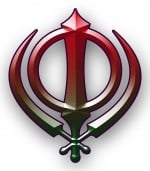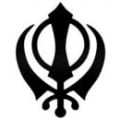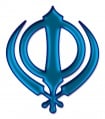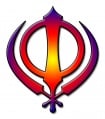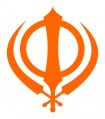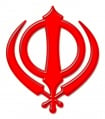Khanda: Difference between revisions
Hari singh (talk | contribs) No edit summary |
Hari singh (talk | contribs) No edit summary |
||
| Line 1: | Line 1: | ||
==The Insignia of the Khalsa== | ==The Insignia of the Khalsa== | ||
[[Image:CANADA_Sikh_Stamp.jpg|150px|left|thumb|Sikh '''Khanda''' on Stamp designed by ''Stacey Zabolotney'' Issued By Canada Post in November 2000.]] | |||
[[Image:Khanda1.gif|150px|right]] | [[Image:Khanda1.gif|150px|right]] | ||
[[ | |||
The '''Khanda''' {{lang-pa|ਖੰਡਾ}}, ''{{IAST|khaṇḝĝ}}'') is one of most important symbols of [[Sikhism]]. This is emphasized by the fact that many Sikh flags, including the [[Nishan Sahib]] have the Khanda on them. It is a collection of four weapons commonly used by [[Sikhs]] at the time of [[Guru Gobind Singh]]. | |||
In the centre of the insignia is the two-edged sword which symbolises the Creative Power of God which controls the destiny of the whole universe. It is the Sovereign Power over life and death. One edge of the Sword symbolises divine justice, which chastises and punishes the wicked oppressors; the other edge symbolises Freedom, and Authority governed by moral and spiritual values. | In the centre of the insignia is the two-edged sword which symbolises the Creative Power of God which controls the destiny of the whole universe. It is the Sovereign Power over life and death. One edge of the Sword symbolises divine justice, which chastises and punishes the wicked oppressors; the other edge symbolises Freedom, and Authority governed by moral and spiritual values. | ||
On the outside of the two-edged sword, we can see two swords: | On the outside of the two-edged sword, we can see two swords: | ||
*On the left is the Sword of Spiritual Sovereignty (Piri); | |||
*On the left is the Sword of Spiritual Sovereignty ([[Piri]]); | |||
[[Image:Khanda Dark Red Chiselled.jpg|150px|right]] | |||
The ''Chakra / Chakkar'' which was worn by the great martyr [[Baba Deep Singh]] is still preserved in the sanctum sanctorium of the Akal Takht. On it is | *On the right is the Sword of Political Sovereignty ([[Miri]]) | ||
There must always be a balance between the two, and this balance is emphasised by a circle inside. This circle is what is called a ''[[Chakra]]'' or ''Chakkar''. The ''Chakra'' is a symbol of all embracing Divine Manifestation, including everything and wanting nothing, without beginning or end, neither first nor last, timeless, Absolute. It is the symbol of oneness, of Unicity of Justice, Humanity and the Immortality. Almost all Sikh warriors used to wear it in the eighteenth century, and Nihangs of today still do. | |||
The ''Chakra / [[Chakkar]]'' which was worn by the great martyr [[Baba Deep Singh]] is still preserved in the sanctum sanctorium of the [[Akal Takht]]. On it is inscribed the [[Mool Mantar]] and that is what it symbolises. | |||
==References== | ==References== | ||
* {{Book reference | Author=Singh, Trilochan | Title=Turban and Sword of the Sikhs| Publisher= | Year=| ID=ISBN }} | * {{Book reference | Author=Singh, Trilochan | Title=Turban and Sword of the Sikhs| Publisher= | Year=| ID=ISBN }} | ||
Revision as of 21:33, 28 January 2008
The Insignia of the Khalsa
The Khanda Punjabi: ਖੰਡਾ, khaṇḝĝ) is one of most important symbols of Sikhism. This is emphasized by the fact that many Sikh flags, including the Nishan Sahib have the Khanda on them. It is a collection of four weapons commonly used by Sikhs at the time of Guru Gobind Singh.
In the centre of the insignia is the two-edged sword which symbolises the Creative Power of God which controls the destiny of the whole universe. It is the Sovereign Power over life and death. One edge of the Sword symbolises divine justice, which chastises and punishes the wicked oppressors; the other edge symbolises Freedom, and Authority governed by moral and spiritual values.
On the outside of the two-edged sword, we can see two swords:
- On the left is the Sword of Spiritual Sovereignty (Piri);
- On the right is the Sword of Political Sovereignty (Miri)
There must always be a balance between the two, and this balance is emphasised by a circle inside. This circle is what is called a Chakra or Chakkar. The Chakra is a symbol of all embracing Divine Manifestation, including everything and wanting nothing, without beginning or end, neither first nor last, timeless, Absolute. It is the symbol of oneness, of Unicity of Justice, Humanity and the Immortality. Almost all Sikh warriors used to wear it in the eighteenth century, and Nihangs of today still do.
The Chakra / Chakkar which was worn by the great martyr Baba Deep Singh is still preserved in the sanctum sanctorium of the Akal Takht. On it is inscribed the Mool Mantar and that is what it symbolises.
References
- Singh, Trilochan (). Turban and Sword of the Sikhs. . ISBN.
Gallery
These images have no copyright. Please feel free to liberally use them:
